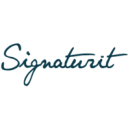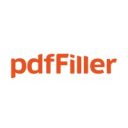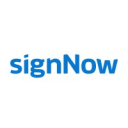DocuSign vs Signaturit: Choosing your e-signature platform
- 01DocuSign vs Signaturit: overview
- 02What's the difference between DocuSign and Signaturit?
- 03DocuSign pros and cons
- 04Signaturit pros and cons
- 05DocuSign compared to Signaturit
- 06Signaturit compared to DocuSign
- 07Features comparison
- 08DocuSign vs Signaturit: Which is the best for your business?
- 09Promotions on Digital Signature software
- 10Alternatives to DocuSign & Signaturit
Save up to $1,497 on Signaturit
Save up to $1,497 on Signaturit
If you’re in need of a reliable digital signature solution for your business, the market presents several robust options. Among these, DocuSign and Signaturit stand out as prominent choices, each offering distinct advantages and challenges.
To aid you in choosing the most suitable platform for your enterprise, we delve into a detailed comparison of DocuSign vs. Signaturit, covering their key features, differences, and ideal use cases. With this analysis, you'll be better prepared to discern which service aligns with your business requirements, priorities, and goals. Continue reading to discover more!
DocuSign vs Signaturit: overview
DocuSign and Signaturit are formidable contenders in the realm of electronic signature platforms, each offering a unique set of features and capabilities.
DocuSign is renowned for its extensive integration options and global reach, making it a preferred choice for large enterprises needing robust, scalable solutions. Its intuitive interface allows users to easily send, sign, and manage documents from anywhere, on any device. On the other hand, Signaturit is known for its strong compliance with European regulations, making it an excellent option for businesses operating within the EU. It provides a straightforward, secure way to obtain electronic signatures without requiring recipients to register or download any software.
Let's explore further into the DocuSign vs. Signaturit comparison to help you determine the most suitable e-signature platform tailored to your specific business needs.
What's the difference between DocuSign and Signaturit?
DocuSign and Signaturit are both prominent players in the digital signature industry, but they cater to slightly different needs and markets, which is reflected in their features and offerings. Understanding these differences is crucial for businesses choosing between the two.
DocuSign is widely recognized for its comprehensive suite of features that support a range of industries globally, including real estate, finance, healthcare, and more. It offers extensive integration capabilities with other software systems, such as Salesforce, Google, and Microsoft. This makes it ideal for large enterprises that require a seamless flow of operations across various platforms. Additionally, DocuSign's robust API allows developers to customize the solution to fit specific organizational needs, adding to its flexibility.
In contrast, Signaturit focuses more on legal compliance and security, especially within the European market. It complies with EU regulations such as eIDAS, GDPR, and similar standards, making it a suitable choice for businesses operating within Europe who need to adhere strictly to local laws. Signaturit offers a more streamlined user experience with no need for account creation by document signers, which can simplify the process for clients and partners who might be less tech-savvy.
Another key difference is in their approach to user interface and management. DocuSign provides a feature-rich dashboard that can handle complex workflows and multiple document processes, which might be more than what smaller companies need. Signaturit, on the other hand, offers a more straightforward, user-friendly interface that might be easier for smaller teams to adopt without extensive training.
Lastly, pricing structures between the two vary significantly. DocuSign typically operates on a per-user basis with various tiers that add more features as the prices increase, suitable for larger organizations that can forecast their needs and scale accordingly. Signaturit, while also offering tiered pricing, tends to be more cost-effective for smaller businesses or those with less frequent need for electronic signatures.
DocuSign pros and cons
What are the advantages of DocuSign?
- Global reach and compliance: DocuSign meets widespread international legal standards, including eIDAS, making it suitable for global businesses that need to comply with various regulations across different regions.
- Extensive integrations: It integrates seamlessly with a broad range of systems and applications such as Salesforce, Google, Microsoft, and more, which facilitates a more streamlined workflow and reduces the need for switching between applications.
- Robust features: Offers a comprehensive set of features including advanced authentication options, audit trails, mobile app access, and customized templates, which cater to complex business needs and a variety of industries.
- Scalability: Well-suited for both small businesses and large enterprises, DocuSign's scalable platform can handle vast amounts of documents and users, making it ideal for companies that expect to grow or experience fluctuating volumes of document handling.
- Strong security: Ensures top-tier security with encryption and compliance with standards such as ISO 27001, SSAE 16, and PCI DSS, which is crucial for handling sensitive information securely.
What are the disadvantages of DocuSign?
- Cost: Can be relatively expensive, especially for small businesses or those that do not require a comprehensive suite of features. The cost increases with the number of users and the addition of advanced features.
- Complexity: While feature-rich, the wide array of options and settings can be overwhelming for new users or small businesses that need simpler solutions.
- Learning curve: The extensive functionalities and integration capabilities can require a significant investment in training and familiarization, which might be a barrier for companies without dedicated IT support.
- Overhead for small scale uses: For businesses that only need basic e-signature capabilities, DocuSign’s extensive features might be more than necessary, leading to underutilization of the service.
- Customer service issues: Some users report delays or difficulties in receiving support, which can be a significant disadvantage when urgent issues arise needing prompt resolutions.
Compare DocuSign to other tools
Signaturit pros and cons
What are the advantages of Signaturit?
- Strong compliance with European laws: Signaturit is specifically designed to comply with European regulations such as eIDAS, GDPR, and other local laws, making it highly suitable for businesses operating within the EU who need to ensure legal compliance.
- User-friendly interface: The platform is known for its straightforward and intuitive interface, which simplifies the process of sending, signing, and managing documents, especially for users with little to no technical expertise.
- No need for account creation by recipients: Recipients can sign documents without having to create an account or install any software, which enhances the user experience and can increase the speed of document turnaround.
- Strong focus on security: Signaturit offers advanced security measures, including SMS authentication and audit trails that ensure the integrity and confidentiality of documents.
- Cost-effective: Typically offers a more budget-friendly pricing structure compared to some of its larger competitors, which is advantageous for small to medium-sized enterprises or those with less frequent needs for electronic signatures.
What are the disadvantages of Signaturit?
- Limited integrations: Compared to competitors like DocuSign, Signaturit offers fewer integrations with external business tools and software systems, which might require additional steps or manual interventions for users who rely on these integrations.
- Less scalable: While effective for small to medium-sized businesses, Signaturit may not be as suitable for very large enterprises or those with highly complex document management needs due to its simpler setup and fewer customization options.
- Limited global recognition: Although well-recognized within Europe, Signaturit might not be as widely acknowledged outside the EU, potentially affecting businesses that operate on a global scale.
- Feature set: While sufficient for basic and moderately advanced needs, Signaturit’s feature set might not be as comprehensive as some of the larger platforms, potentially limiting users who require specific functionalities.
- Customer support: Some users report that customer support can be less responsive or slower, which could be a concern when immediate assistance or troubleshooting is required.
DocuSign compared to Signaturit
DocuSign and Signaturit both provide electronic signature solutions, but they cater to different needs. DocuSign offers a broad range of integrations and features that support complex global operations and is particularly well-suited for large enterprises requiring robust scalability and compliance with international standards. In contrast, Signaturit excels in providing a user-friendly interface and compliance with European regulations, making it ideal for EU-based businesses or those needing straightforward solutions without complex integrations.
While DocuSign may be more costly and complex, it offers comprehensive functionality. Signaturit, meanwhile, provides essential services more cost-effectively, though with fewer features and integrations.
Is DocuSign better than Signaturit?
Determining whether DocuSign is better than Signaturit hinges on the specific requirements of your business. DocuSign shines in environments that demand extensive scalability and deep integration with other enterprise systems, making it an excellent choice for multinational corporations managing a high volume of transactions across diverse locations. It is adept at handling intricate, regulatory-compliant workflows, offering a security level that satisfies international standards.
On the other hand, if your priority is ease of use and cost efficiency, particularly within the European context, Signaturit may be the superior choice, especially for smaller businesses or those less reliant on broad software integrations.
What is DocuSign best used for?
DocuSign is best used for managing electronic agreements and signatures across a broad range of industries, including real estate, finance, healthcare, and government. Its comprehensive platform facilitates the sending, signing, and managing of documents securely and efficiently from virtually anywhere in the world.
Ideal for large enterprises needing to integrate with other business systems like Salesforce or Microsoft, DocuSign supports extensive customization and automation of workflows, making it a robust solution for organizations looking to streamline their contract management processes while adhering to international compliance standards. Its scalability also makes it suitable for businesses planning to expand their digital operations globally.
Can DocuSign replace Signaturit?
DocuSign can replace Signaturit for businesses seeking a more feature-rich and globally recognized electronic signature solution. With its extensive integration capabilities, broader compliance with international standards, and advanced security features, DocuSign offers a compelling alternative for organizations requiring comprehensive document management tools and robust scalability.
However, for companies primarily operating within the European market, the transition might involve adjustments due to Signaturit's specific compliance with EU regulations. Although DocuSign is generally more expensive, its extensive functionalities make it a suitable upgrade for enterprises looking to enhance their digital transaction management on a larger or more diverse scale.
Is DocuSign cheaper than Signaturit?
DocuSign’s pricing plans generally are not cheaper than Signaturit. While both platforms offer tiered pricing structures to accommodate different business needs, DocuSign's comprehensive feature set and broad integration capabilities tend to make it a more expensive option. It is designed to serve a wide range of industries globally, which can add to the cost, especially for businesses seeking advanced functionality and extensive scalability.
In contrast, Signaturit provides a more cost-effective solution with essential features that meet the needs of small to medium-sized businesses, particularly those operating within Europe and requiring compliance with specific EU regulations. This makes Signaturit a more budget-friendly option for those with simpler requirements.
Is there a better Digital Signature software than DocuSign?
While DocuSign is a leader in electronic signature technology, known for its extensive integration capabilities and global compliance, it is essential to consider whether alternative platforms might align more closely with your specific needs.
Several noteworthy alternatives to DocuSign in the digital signature and document management space include Adobe Sign, HelloSign, signNow, and Signaturit. The choice of the right platform depends on your organization’s unique requirements, budget constraints, and the level of customization and user experience you prioritize. While DocuSign excels in offering a broad range of features and extensive scalability, other platforms might provide more cost-effective solutions, simpler user interfaces, or specialized features that better meet the demands of your specific workflow or regional compliance needs.
Signaturit compared to DocuSign
Signaturit stands out from DocuSign by focusing on streamlined user experience and compliance with European regulations, making it particularly beneficial for EU-based businesses.
While DocuSign boasts comprehensive features and global scalability that appeal to large, diverse enterprises, Signaturit offers a simpler, more cost-effective solution. It allows recipients to sign documents without needing an account, enhancing convenience for less tech-savvy users. However, Signaturit's limited integration capabilities and feature set might not satisfy organizations requiring extensive customization. For businesses prioritizing ease of use and EU legal compliance over global integration and advanced features, Signaturit presents a compelling alternative to DocuSign.
Is Signaturit better than DocuSign?
Whether Signaturit is better than DocuSign depends largely on the scale and nature of your business needs. For companies primarily operating within Europe, Signaturit's strong alignment with EU regulations makes it an ideal choice, ensuring compliance with local legal standards while providing a straightforward, no-frills electronic signature service. Its simplicity and cost-effectiveness are particularly advantageous for smaller businesses or those without complex integration needs.
Moreover, the feature allowing recipients to sign without an account streamlines the process, removing barriers for users unfamiliar with digital tools. Therefore, for entities prioritizing regional compliance and user-friendly operations, Signaturit could indeed be the superior option over DocuSign.
What is Signaturit best used for?
Signaturit is best suited for businesses that need a straightforward and efficient electronic signature solution, particularly within the European market. It excels in environments where legal compliance with EU regulations, such as eIDAS and GDPR, is crucial. The platform's ease of use, requiring no account creation by signers, makes it ideal for small to medium-sized businesses or sectors where rapid document turnover is necessary.
Signaturit is particularly beneficial for companies that prioritize a seamless signing experience for their clients without the complexity of additional software installations, making it a practical choice for legal, real estate, and human resources departments.
Can Signaturit replace DocuSign?
Signaturit can replace DocuSign for businesses that prioritize simplicity and compliance with European legal standards over extensive customization and global scalability. While DocuSign offers a robust suite of features suitable for large enterprises and a wide range of integrations, Signaturit provides a more streamlined approach that is particularly appealing to small to medium-sized businesses within Europe. Its user-friendly interface and the ability for recipients to sign documents without creating an account make it accessible and efficient.
However, companies requiring deep integration with other business systems or operating on a global scale might find DocuSign's extensive capabilities more fitting.
Is Signaturit cheaper than DocuSign?
Signaturit is generally cheaper than DocuSign, making it an attractive option for small to medium-sized businesses or those with less frequent needs for digital signature services. This cost advantage stems from Signaturit's straightforward pricing structure, which is designed to accommodate businesses looking for essential features without the complexity or expense of more extensive systems.
While DocuSign offers advanced functionality and integration capabilities suited to larger enterprises, its pricing reflects this breadth, potentially making it less accessible for smaller operations or those on tighter budgets. Signaturit’s affordability, coupled with its focus on EU compliance, offers a compelling alternative for cost-conscious businesses.
Is there a better Digital Signature software than Signaturit?
While Signaturit is praised for its simplicity and strong compliance with EU regulations, it's essential to consider if there might be other platforms that better suit your specific needs.
Notable alternatives to Signaturit in the digital signature space include DocuSign, Oneflow, DocSend, Zoho Sign, and PandaDoc. Your selection of a digital signature platform should align with your organization's unique requirements, budget, and the level of integration and user experience you desire. While Signaturit excels in providing a user-friendly interface and ensuring EU legal compliance, other platforms may offer more extensive customization options, broader global compliance, or additional features that better meet your business's operational demands.
50% off on Business, Business + and API plans on Signaturit
Get 50% off on Business, Business + and API plans on Signaturit and up to $1,497 savings with Secret.
Features comparison
DocuSign Enhances Document Handling Over Signaturit
DocuSign stands out in its ability to efficiently capture and manage documents from a variety of sources, significantly enhancing user experience and collaborative potential. Its robust system allows for seamless storage of files in the cloud, ensuring secure and universal access across devices and platforms. This feature is particularly beneficial for organizations that handle large volumes of documents and require frequent access by multiple teams, such as law firms and financial institutions. For example, a legal team can instantly access and work on case files from anywhere, simplifying workflow and boosting productivity.
In contrast, while Signaturit offers a user-friendly interface that simplifies sending and managing documents, it lacks the explicit document capture functionality that DocuSign provides. Signaturit’s platform focuses more on the signing process and less on the initial stages of document management, which can be a drawback for businesses that need to integrate document capture directly into their document workflow systems. This difference makes DocuSign a more comprehensive solution for organizations looking for extensive document handling capabilities along with electronic signatures.
Signaturit Offers More Diverse Signing Options Than DocuSign
Signaturit distinguishes itself from DocuSign by providing a wider array of advanced signature options, tailored to meet different legal and security requirements. The platform allows users to choose from simple electronic signatures, advanced biometric signatures that capture unique patterns in handwriting, and even qualified electronic signatures, which are issued directly by Signaturit and provide the highest level of security and legal compliance. This variety not only enhances the security of the documents but also ensures that the signatures are legally binding across various jurisdictions, particularly in the European Union where such distinctions are crucial.
While DocuSign also offers robust signature capabilities, including mobile options that allow users to sign documents on-the-go, it lacks the same level of differentiation in the types of signatures offered. For businesses that require a higher assurance level and more detailed authentication, such as legal firms, healthcare providers, or government entities dealing with sensitive information, Signaturit's comprehensive options provide a significant advantage. This makes the signing process not only more efficient but also more adaptable to specific compliance needs.
DocuSign and Signaturit Both Excel in Providing Robust Security Features
DocuSign and Signaturit both offer comprehensive security features that ensure documents are not only secure but also legally binding, catering to the stringent needs of businesses in various sectors. DocuSign is particularly renowned for its high-level security measures, which include bank-level encryption, robust authentication mechanisms, and detailed audit trails that document every interaction with a file. This level of security is crucial for industries like banking and healthcare, where protecting sensitive information is paramount.
Similarly, Signaturit also emphasizes strong security practices by offering advanced signature options that go beyond simple electronic signatures. It complies with the ISO/IEC 27001:2014 standard, one of the most rigorous global security management standards, ensuring that data protection practices meet international requirements. Signaturit’s focus on advanced and qualified electronic signatures provides an additional layer of security by verifying the signer's identity more thoroughly, which is especially important for legal and governmental entities.
Signaturit Excels in Branding Features Over DocuSign
Signaturit stands out for its customizable branding options, allowing businesses to enhance their brand recognition by personalizing emails and documents with their logos, colors, and corporate identity. This feature is particularly beneficial for firms that prioritize maintaining brand consistency across all customer touchpoints, which can significantly enhance the customer experience and reinforce brand loyalty. For instance, a real estate agency could use Signaturit to ensure all contract communications carry its distinctive branding, making each interaction recognizable and professional.
In contrast, while DocuSign excels in ensuring secure and compliant document transactions, it lacks the same level of explicit branding customization that Signaturit offers. DocuSign focuses more on the functionality and security of the signing process rather than the aesthetic aspects of document interaction. This may limit businesses that are keen on leveraging every customer interaction as a branding opportunity, especially those in consumer-facing sectors where brand image plays a critical role in customer engagement and retention.
DocuSign Offers a More Extensive Range of Integrations Compared to Signaturit
DocuSign and Signaturit both enhance their utility through numerous integration possibilities, though with varying degrees of breadth and technical flexibility. DocuSign significantly outpaces its competitor with over 900 pre-built integrations with commonly used CRM software, productivity tools, communication software, and other business tools, such as Salesforce, Google Suite, Microsoft 365, and Slack. This extensive connectivity makes it highly adaptable to various business environments, ensuring that it can seamlessly sync with nearly any existing software ecosystem. For example, a real estate agency using DocuSign can integrate it with their CRM to automate the flow of client agreement processes without manual data entry.
On the other side, Signaturit also supports integrations with key business applications like Salesforce and Dropbox but offers fewer out-of-the-box options compared to DocuSign. However, Signaturit counters this by providing a robust API, which is ideal for businesses with specific needs not covered by standard integrations.
DocuSign Leads in Workflow Automation Over Signaturit
DocuSign excels in enhancing operational efficiency through its advanced process automation capabilities, allowing businesses to streamline workflows, speed up approval processes, and thereby increase overall productivity. By automating routine tasks such as document routing, reminders, and follow-ups, DocuSign significantly reduces the manual effort required, enabling staff to focus on more strategic tasks. For instance, in sectors like real estate or finance, where multiple approvals are common, DocuSign's automation tools can configure complex workflows to ensure documents move smoothly from one stage to the next without human intervention.
Conversely, while Signaturit provides a robust platform with a strong legal framework and secure processing, it lacks the sophisticated workflow automation features that DocuSign offers. Signaturit focuses on ensuring the legality and security of the signature process, which is crucial for compliance-heavy industries, but does not have the same breadth of automation tools to facilitate workflow management. This limitation may affect businesses looking to optimize their document handling processes fully, particularly those with high document throughput or those needing to coordinate multiple departments or stakeholders.
DocuSign Leads in User Interface Ease Over Signaturit
In terms of ease-of-use and user interface, DocuSign undoubtedly takes the lead. Having established itself early in the industry, DocuSign has developed a more mature and robust platform. Its interface is notably user-friendly, designed with simplicity in mind to ensure that even the least tech-savvy users find the signing process straightforward and manageable. This is particularly beneficial in scenarios where quick and error-free document handling is crucial, such as closing real estate transactions or finalizing urgent contracts.
Conversely, Signaturit also provides a clean and modern interface, but it sometimes falls short of DocuSign's intuitive design. Some users report that although Signaturit's layout is visually appealing, it can initially present minor navigational challenges, requiring a bit of a learning curve to become proficient. For example, new users might take longer to locate certain functions or to understand the steps needed to send a document for signing. Despite these small hurdles, Signaturit remains user-friendly, but it might not be as immediately accessible as DocuSign, especially for those with limited digital fluency.
Subscribe to our newsletters.
No FOMO here. Stay up-to-date on all the latest deals and news with our monthly newsletter straight to your inbox like 126,000+ entrepreneurs (+ Get 10% off on on our Premium Membership!)
DocuSign vs Signaturit: Which is the best for your business?
DocuSign is the best tool for you if:
- You require a highly scalable solution that can handle vast volumes of documents and users, making it ideal for large enterprises with complex workflows.
- Your business needs extensive integration capabilities with other software systems like Salesforce, Google, and Microsoft, facilitating a seamless workflow across various platforms.
- You prioritize legal compliance and need a solution that adheres to a wide range of international regulations, including eIDAS, GDPR, and UETA.
- You are looking for advanced features like bulk sending, advanced authentication, and detailed audit trails to enhance document security and management efficiency.
- You value a robust mobile platform that allows users to manage and sign documents on the go, ensuring business continuity regardless of location.
Signaturit is the best tool for you if:
- Your operations are primarily within the EU and you require strict adherence to European regulations like eIDAS and GDPR for legal compliance and data protection.
- You prefer a straightforward, user-friendly interface that allows for easy navigation and efficient document management without the need for extensive training or technical knowledge.
- You value the convenience of allowing recipients to sign documents without needing to create an account, making the process smoother and faster for first-time users.
- You need a cost-effective digital signature solution that provides essential services without the overhead of more complex and expensive platforms.
- Customization and personal branding are important to you, as Signaturit allows for the personalization of emails and documents to maintain consistency with your brand identity.
Alternatives to DocuSign & Signaturit
Promotions on Digital Signature software
Start saving on the best SaaS with Secret.
Secret has already helped tens of thousands of startups save millions on the best SaaS like DocuSign, Signaturit & many more. Join Secret now to buy software the smart way.












